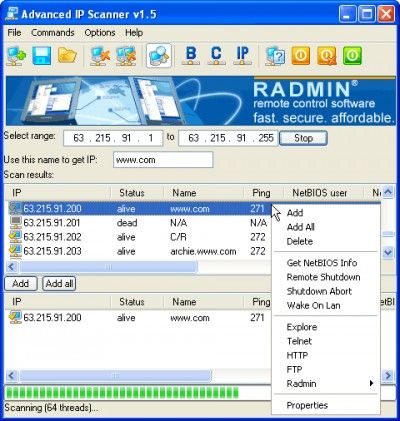

This allows your organization to focus on more important tasks while your system runs IPAM scans regularly to find IP addresses. IP network scanners eliminate the need for teams to devote extensive amounts of time to upkeep their operational infrastructure through automation. In a high-functioning environment, manually scanning for network disruptions can be cumbersome and overwhelming. Maintaining network efficiency and troubleshooting connectivity problems becomes a breeze with IP scanners, making them a necessity for enterprises that depend on seamless operability, day in and day out. Reactive polling uses SNMP traps, which notify the IP scanner of any anomalies a device is experiencing within the network. Proactive polling involves initiating this communication to receive an SNMP message from the target device in order to gain information about it. They do this by polling an in-network device through UDP port 161, either proactively or reactively. With SNMP, IP network scanners can gather comprehensive information about the devices that communicate with each other within the same network. IP scanners can also dive deeper into their networks by using Simple Network Management Protocol (SNMP). In turn, those hosts will respond with an echo reply packet that gives the requestor insight into the status of their IP addresses, response times, latency issues, and more. To initiate a ping sweep, the IP address scanner sends an ICMP echo request via message packets to IP addresses on other devices a user wishes to analyze. ICMP is responsible for notifying users about a variety of network communication issues, such as connectivity failures and server malfunctions, through error messages.

IP scanners are capable of conducting ping sweeps using Internet Control Message Protocol (ICMP), which is integrated into any IP suite. These tools help you manage your IP addresses and troubleshoot problems, and they also help you find all the IP addresses of the devices on your network and determine the status of each one (dynamic, static, available, reserved, etc.). Instead of attempting to manually manage these aspects of your network, I recommend using an IP address manager (IPAM), which includes IP scanners. Multiple subnets and an ever-changing string of devices connecting to and disconnecting from the network become problematic. It becomes pretty clear as your network scales, that manually scanning for IP addresses becomes an extremely complex task. This means that if you have multiple subnets on your network, you have to go through each individual router or subnet to determine the IP addresses within the subnet. However, this method doesn’t work across subnets.
#Advanced ip mac#
#Advanced ip how to#
Picking the Best IP Scanner – My Top ChoiceĬurious how to find IP addresses on network? You may need to know about either static or dynamic IP addresses.
#Advanced ip free#
SolarWinds Network Topology Mapper (14-Days Free Trial) SolarWinds IP Address Manager (30-Days Free Trial)ģ. The Impact of IP Scanners on Network Securityġ. How to Find IP Addresses of Devices on My Network It’s more approachable than some of the other tools out there and has a flatter learning curve for figuring out how to get started. My top choice for a network scanning tool is SolarWinds® IP Address Manager, as it works in an intuitive and easy-to-use way while offering a broad suite of tools and functions. Manually finding IP addresses on your network is possible, but why do it yourself when there are so many tools to help you? Not only can network scanning tools help you find IP addresses, but they can also provide extra information for monitoring, troubleshooting, and keeping your network running efficiently. Network scanning is a necessary task, but it can start off simple and rapidly become more complicated as your business gets larger.


 0 kommentar(er)
0 kommentar(er)
